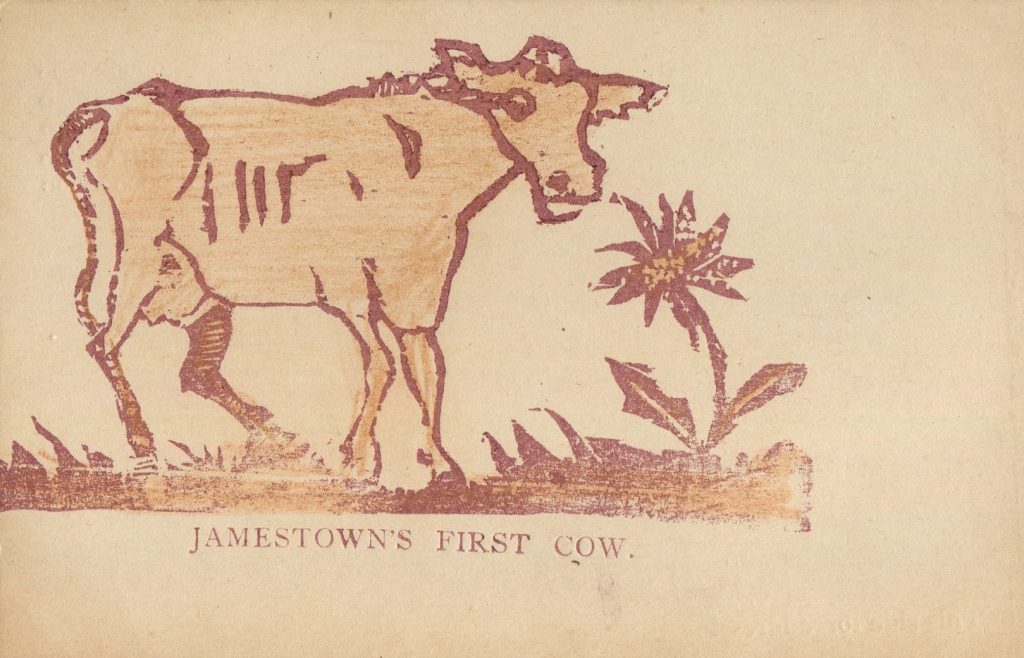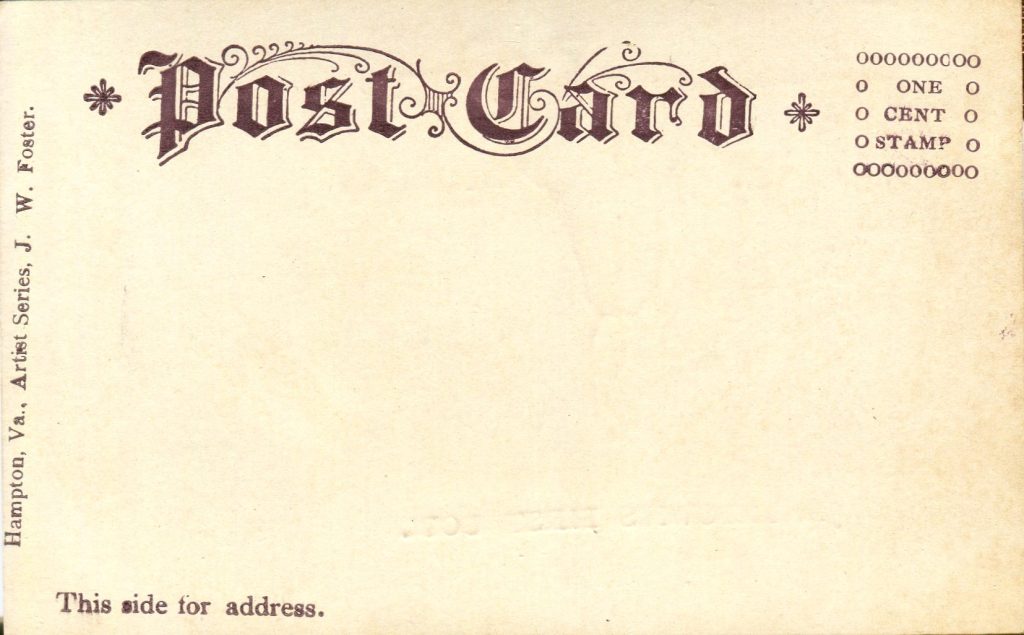Ray Hahn
Jamestown’s First Cow
Postcard History Online Magazine became aware of Jesse Webster Foster when an album of postcards was presented to us by J. A. Lawson, a Virginia postcard dealer. John had promised a friend and client that he would learn about Mr. Foster and in turn, John asked our help. We were delighted to have such an opportunity to do this original research and present it to you, our readers.
The postcards in the album are best described as a cache of oddities, but also a treasure of unique images from the hand of a truly talented American primitive artist.
Jamestown’s First Cow is but one of the images. It is art that demands your attention because it is the image that needs to be explored, wondered about, and learned from, not the message.

The first fact discovered in the exploration of this card was that the manufacturer was a Hampton, Virginia, concern that was likely a low-budget operation in which wood-block publishing was done in very small numbers. There is a left-edge credit on the address-side that offers this, “Hampton, Va., Artist Series, J. W. Foster.”
[And before you think it, yes, the printing is quite askew. The scan has a perfect 90° corner.]

Jamestown’s First Cow is one card from a group of twenty. The word group is used here for calling this lot a set would stretch the definition of a set as being two or more cards, published together with a common theme. These twenty cards have no commonality. The topics related to the images range from Virginia landmarks, personalities, history, and characters to the weather in Oklahoma, Thanksgiving greetings, and what the factors are in an “awful time.”
With all this in mind it was no surprise to learn that Jesse Webster Foster was quite a well-known Congregational Church pastor who was affectionately known as the “artist evangelist.”
Supposition and assumption are often the only “facts” available in historical research and in this instance the best assumption concerning these postcards is that Reverend Foster used them in his parable teachings (and perhaps sermons) and afterward gave the cards to his parishioners as souvenirs or keepsakes.
* * *

This face makes me laugh. What was in the mind of the artist?
We will never know the answer, but after researching a topic as simplistic as “bovines in Jamestown,” one possible answer may be that cattle are not native to Virginia and how and when they got here made a good story. A parable, so to speak, of Noah and why there were two of each species on the ark.
It is suspected that cows were introduced to Virginia by the settlers who came to Jamestown in a period after 1607. Those who care about such things simply do not know if the very first Jamestown colonists brought cattle in 1607 or even if there were any here in 1608 and 1609.
The reason we don’t know is because in those days the word “cattle” meant any four-legged barnyard animals. Thus pigs, goats, sheep, and horses were all “cattle” along with bovines. We know there were “cattle” here, but we don’t know what barnyard species they were.
In the 1600s when someone spoke of a cow (bovine) they would say “kine.” Jamestown archaeologists have found bovine bones in a pit successfully dated to 1610, so this story that the Reverend Foster took to his congregation – without his knowing it – began after 1610.
Those first Virginia cattle did NOT thrive. Cattle graze. The grasses of coastal Virginia are simply insufficient to sustain herds of animals the size of cows. They struggled so much to live that for a short time it was a capital crime in Virginia to kill a cow.
The history of Virginia cattle and how their survival was managed by moving them into the Shenandoah Valley after the 1720s is for a different time. However, if you are a curiosity driven individual, Google the “history of the Wiseman Farm and Bob the Bull in Augusta County, Virginia 1930.”
Caution: if you do, be prepared to laugh.
Very interesting. I like block prints and have a mini grouping of greeting postcards hand-printed like this on the back of governmental postal cards during the Depression and WW II. A grouping of postcards for almost any topic becomes fascinating. Loving hands at home, making do with what they had available, and sharing someone’s creativeness, I enjoy it all.
Since I visited the Jamestown site as a teen and later attended a school that now bills itself as “Coastal Virginia’s Premier University of the Liberal Arts and Sciences”, this article was of special interest to me.
An excellent article. I enjoyed your lecture in Hampton last week.